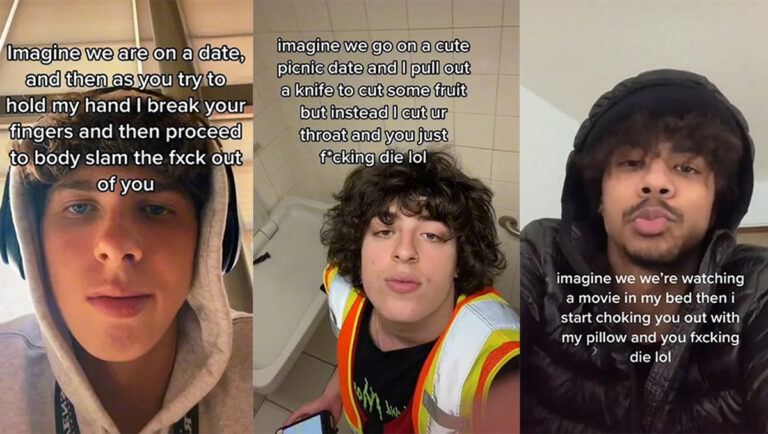Men on TikTok are fantasising about ways to hurt women on imaginary dates

There’s a new trend on TikTok where cis, straight-presenting male creators post point of view (POV) videos of themselves fantasising about dates with women and how they would turn violent. After it picked up on the video-sharing app, critics have highlighted how the imaginary date trend breaks TikTok’s terms of service and promotes physical violence against women.
One user who has taken part in the worrying trend is Danny Garcia, who currently has just under 15,000 followers on TikTok. Sure, we’re not talking about someone who’s at a Charli D’Amelio level, but it’s clear that Garcia’s content still managed to impact a considerable part of the app’s impressionable audience.
In a now-deleted video, Garcia could be seen filming himself in selfie mode with the Frank Ocean song ‘Lost’ playing in the background and superimposed text that read: “Imagine we go on a cute picnic date and I pull out a knife to cut some fruit. But instead I cut ur throat and you just f*cking die lol.”
Another one said, “Imagine I take you to the Grand Canyon for our first date and I push you off the cliff and you fxcking die.”
@divergentredhed #greenscreen DV is not a joke #5hannon #dobetter #dvsurvivor #misogynistic #allmen #notallmen
♬ original sound - EX7STENCE™
On 15 March, female TikToker Kami Ratliff called out the trend and those participating in it by quoting the very same phrasing they use but aimed at exposing them instead. “Imagine being a woman and seeing all of these men fantasise about the ways they’d graphically kill you,” she wrote in her video’s caption. She also included the hashtags #domesticabuseawareness #domesticviolenceawareness and #domesticviolencesurvivor.
Nine creators, including Garcia, are shown in Ratliff’s video. Other imaginary scenarios exposed by Ratliff include “imagine we try BDSM, you let me tie you up then I just punch you in the ribs mad times,” and “imagine we go on a bowling date and I palm your scalp and throw you down the aisle and you die in the machine thingy at the end.”
TikToker Aiden Grollman posted a, you guessed it, now-deleted video that said, “Imagine we are on a date and then as you try to hold my hand I break your fingers and then proceed to body slam the fxck out of you.” After the Daily Dot reached out to him on Instagram, Grollman tried to justify that the trend is a “joke” via direct message.
Another teen male, user Eli Gibson created a now-deleted TikTok video in which he said, “Imagine we go to Topgolf and I miss every shot and your beating me by 30 so I take a driver and beat tf outta you and shove a 9 iron down your throat.” SCREENSHOT was unable to find his account on the app. No surprise here, Gibson also said that his video was a joke.
“I never meant any disrespect by it,” he told the Daily Dot on Instagram. “I literally just copied another [TikTok].” He continued, “I do not promote abuse against women.” Funny thing to say for someone who literally promoted abuse against women.
Ratliff also spoke to the publication and said that while she understood that the TikTok trend was mostly motivated by “boys looking for clout,” she was still “really disturbed” by the videos, especially those that were extra descriptive. “Being killed on dates is something women actually have to be fearful of,” she continued. “I also believe that there is truth behind every joke you tell.”
TikTok’s updated community guidelines state that “content that can cause discomfort, shock or disgust to viewers” may now be “ineligible” to be on a user’s For Your Page (FYP). And yet, here we are, witnessing teen boys trying to impress whoever they’re trying to impress—perhaps the cesspool of misogynists whose humour is anything but funny—by posting POV fantasies about hurting women.
Besides this specific trend, TikTok is home to more graphic, violent and abusive content. Although many have tried reporting some of these, TikTok has avoided deeming them as a violation of its content guidelines. Please, make it make sense.
While 2021 saw the trend of POV fantasy boyfriends rise to fame on TikTok, in 2022 it seems we’re getting an updated version of this imaginary boyfriend—one that disturbingly echoes society’s remaining problem of violence and abuse against women.
According to an Office for National Statistics (ONS) survey, in the UK from March 2020 to March 2021, police recorded a total of 1,459,663 domestic abuse-related incidents and crimes. This was an increase of 79,407 from the previous year.
As reported by the United Nations (UN), globally, even before the COVID-19 pandemic began, one in three women experienced physical or sexual violence, most likely from an intimate partner. Emerging data also shows an increase in calls to domestic violence helplines in many countries since the outbreak of COVID-19. Sexual harassment and other forms of violence against women continue to occur on the streets, in public spaces, at home and now, online. Survivors often have limited information and awareness on support services available to them and when they do, access is sometimes insufficient and finite. Heck, in some countries, resources and efforts were even diverted from violence against women response to immediate COVID-19 relief.
As much as we love how messed up and edgy gen Z humour can be, this trend is not a laughing matter—it’s not even acceptable. How much more will it take for the world to understand that saying #NotAllMen simply isn’t good enough anymore?





